
Membury is a village three miles north west of Axminster in East Devon district. The population at the 2011 Census was 501.
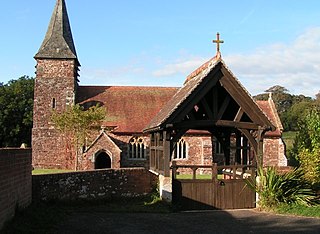
Farringdon is a village, civil parish and former manor in the district of East Devon in the county of Devon, England. The parish is surrounded clockwise from the north by the parishes of Clyst Honiton, Aylesbeare, a small part of Colaton Raleigh, Woodbury, Clyst St Mary and a small part of Sowton.
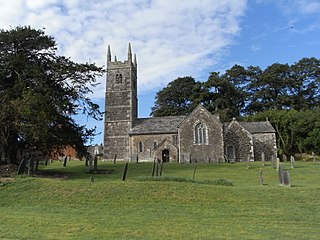
Tetcott is a civil parish, small settlement and former manor in Devon, England. The parish lies about five miles south of the town of Holsworthy and is bordered on the north by the parish of Clawton, on the east by a small part of Ashwater, and on the south by Luffincott. It forms part of the local government district of Torridge, and its western boundary is the River Tamar which forms the Cornish border. In 2001 its population was 110, half that of a century earlier.

Colleton is a hamlet and former manor in the civil parish and ecclesiastical parish of Chulmleigh, in the North Devon district of Devon, England. It is situated on the north side of a valley containing the River Taw. Its nearest town is Chulmleigh, which lies approximately 3.6 miles (5.8 km) to the south-west. It consists of the grade I listed Colleton Barton and Colleton Mill, the former manorial mill, with another former industrial building situated at the approach to the bridge over the River Taw.
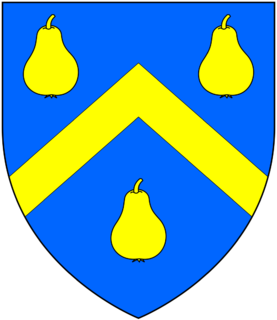
Josias II Calmady of Langdon, in the parish of Wembury, Devon, was Member of Parliament for Okehampton in the Convention Parliament of 1660.

Kentisbeare is a village and civil parish in the Mid Devon district of Devon, England. Its nearest town is Cullompton.

Bradfield House is a Grade I listed country house situated in the parish of Uffculme, Devon, England, 2 miles (3.2 km) south-west of the village of Uffculme.

Annery was an historic estate in the parish of Monkleigh, North Devon.

The Manor of Monkleigh was a mediaeval manor centred on the village of Monkleigh in North Devon, England, situated 2 1/2 miles north-west of Great Torrington and 3 1/2 miles south-east of Bideford.

Dunsland is a historic manor and former house in the parish of Bradford near Holsworthy in Devon, England. It was successively home to the Arscott, Bickford, Coham and Dickinson families and, although the ownership records are incomplete, it is very likely that the estate passed in an unbroken line from the time of the Norman Conquest until 1947. The house was destroyed by fire in 1967, just after extensive restoration by the National Trust.
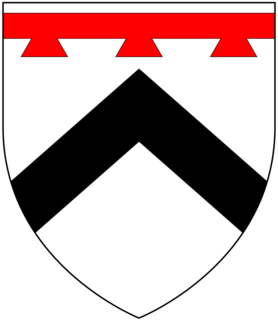
Sir Peter Prideaux, 3rd Baronet (1626–1705), of Netherton in the parish of Farway, near Honiton, Devon, was an English politician.

John Wrey of North Russell, Sourton, and Bridestowe in Devon and Trebeigh, St Ive, Cornwall, was Sheriff of Cornwall in 1587.

Bableigh is an historic estate in the parish of Parkham in North Devon, England. It is separated from the village of Parkham by the Bableigh Brook. It was the earliest recorded seat of the Risdon family in Devonshire, from which was descended the Devon historian Tristram Risdon.

The Manor of Copleston was a manor in the parish of the parish of Colebrooke in Mid Devon, England, now centred on the village of Copplestone.

Soldon in the parish of Holsworthy Hamlets, Devon, England, is a historic estate, a seat of the Prideaux family. The manor house is a grade II listed building dating from the mid-16th century with later alterations. It was sold in 2014 as an eight bedroomed house with an acre and a half of grounds for an asking price of £750,000.
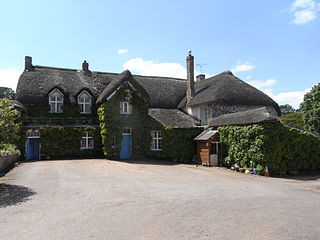
Spencer Combe in the parish of Crediton, Devon, is an historic estate. The grade II listed farmhouse known today as "Spence Combe", the remnant of a former mansion house, is situated 3 miles north-west of the town of Crediton. Spencer Combe is given in several traditional historical sources as the seat of Sir Robert Spencer (d.pre-1510) who married Eleanor Beaufort (1431–1501), the daughter of Edmund Beaufort, 2nd Duke of Somerset (1406–1455), KG, and who was father to two daughters and co-heiresses who made notable marriages. The arms of this Sir Robert Spencer were Sable, two bars nebuly ermine, as shown in the Percy window in the chapel of Petworth House and as quartered by Cary, Viscount Falkland. The American genealogist Douglas Richardson suggests however that Sir Robert Spencer was in fact the son and heir of John Spencer, Esquire, MP for Dorset, of Frampton in Dorset, Ashbury in Devon and Brompton Ralph in Somerset, by his wife Jone. The arms given by Pole for Spencer of Spencer Combe, are: Argent, on a bend sable two pairs of keys or, and are shown quartered by Prideaux on the monument in Farway Church, Devon, to Sir Edmund Prideaux, 1st Baronet of Netherton Hall, and are shown in stained glass impaled by de Esse of Thuborough in the Thuborough Chapel of Sutcombe Church.
Collacombe is an historic manor in the parish of Lamerton, Devon, England. The manor house survives as a grade I listed building, known as Collacombe Barton or Collacombe Manor (House).
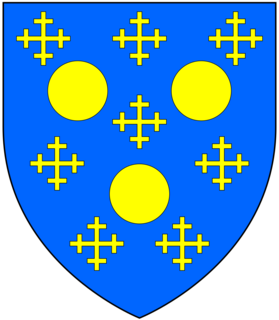
Richard Coffin (1623–1700) of Portledge in the parish of Alwington in North Devon, was lord of the manor of Alwington and served as Sheriff of Devon in 1683.

Ernsborough is an historic Saxon estate dating from the 9th or 11th century, situated in the parish of Swimbridge in Devon, England, about 2 miles south-east of the village of Swimbridge. It is best remembered today for having contained during the 14th century a high-status mansion house occupied by the Mules or De Moels family, closely related to Baron Moels of Somerset.
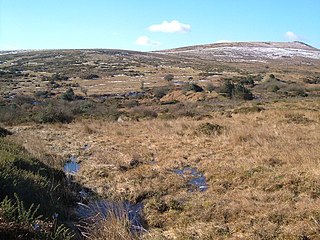
Bagtor is an historic estate in the parish of Ilsington in Devon, England. It was the birthplace of John Ford (1586-c.1639) the playwright and poet. The Elizabethan mansion of the Ford family survives today at Bagtor as the service wing of a later house appended in about 1700.



















